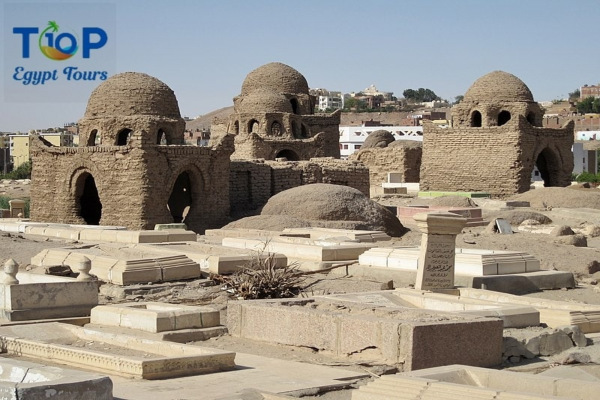The Fatimid Cemetery is a necropolis that dates back to the Fatimid period (969-1171 AD). It is located on a hilltop overlooking the Nile River, about 10 minutes south of Aswan Corniche.
The necropolis of Fatimid contains the tombs of many important Fatimid officials and dignitaries. The tombs are built of mud brick and have a variety of architectural styles, including domed, vaulted, and square tombs. Some of the tombs are decorated with elaborate carvings and inscriptions.
It is an important archaeological site and a popular tourist destination. It is one of the best places to learn about the Fatimid period in Egyptian history.
In this article, we will uncover for you the Fatimid Cemetery with Top Ten Egypt.
History of the Fatimid Cemetery
The necropolis of Fatimid was founded in the 10th century AD, during the reign of the Fatimid Caliph al-Hakim bi-Amr Allah. The cemetery was used by the Fatimids for over 200 years, until the end of the Fatimid dynasty in the 12th century AD.
The cemetery was rediscovered in the 19th century AD by European travelers. The first archaeological excavations at the site were conducted in the early 20th century AD.
Architecture Of The Necropolis Of Fatimid
The tombs in the Fatimid Cemetery are built of mud brick and have a variety of architectural styles. The most common tomb type is the domed tomb. Domed tombs have a square base and a dome-shaped roof. Some domed tombs have decorated drums, which are the cylindrical sections below the domes.
Other tomb types in the Fatimid Cemetery include vaulted tombs and square tombs. Vaulted tombs have a rectangular base and a vaulted roof. Square tombs have a square base and a flat roof.
Some of the tombs in the Fatimid Cemetery are decorated with elaborate carvings and inscriptions. The carvings depict a variety of subjects, including geometric patterns, floral patterns, and Quranic verses.
Importance of the Fatimid Cemetery
It is an important archaeological site because it provides a wealth of information about the Fatimid period in Egyptian history. The tombs in the cemetery contain the remains of many important Fatimid officials and dignitaries. The tombs are also decorated with carvings and inscriptions that provide insights into Fatimid culture and beliefs.
It is also a popular tourist destination. Visitors to the cemetery can learn about the Fatimid period in Egyptian history and see the well-preserved tombs of Fatimid officials and dignitaries.
How to visit the Fatimid Cemetery
It is located on a hilltop overlooking the Nile River, about 10 minutes south of Aswan Corniche. Visitors to the cemetery can take a taxi or tuk-tuk from Aswan Corniche to the cemetery.
The cemetery is open to the public from 9:00 AM to 5:00 PM, seven days a week. There is a small entrance fee to visit the cemetery.
Tips for visiting the Cemetery
- The best time to visit the necropolis of Fatimid is in the morning or late afternoon when the temperatures are cooler.
- Wear comfortable shoes, as you will be doing a bit of walking.
- Bring sunscreen and a hat, as there is not much shade in the cemetery.
- Bring a camera to capture the stunning views of the cemetery and the surrounding area.



Comment (0)